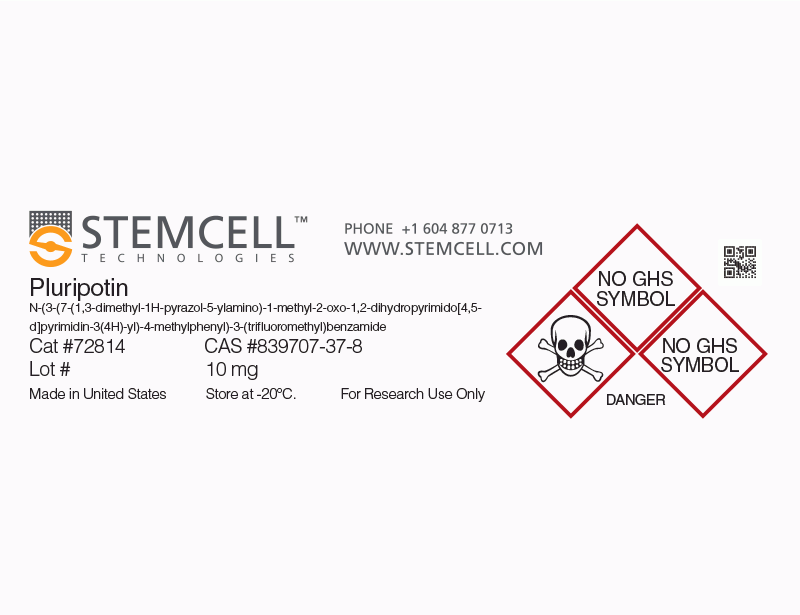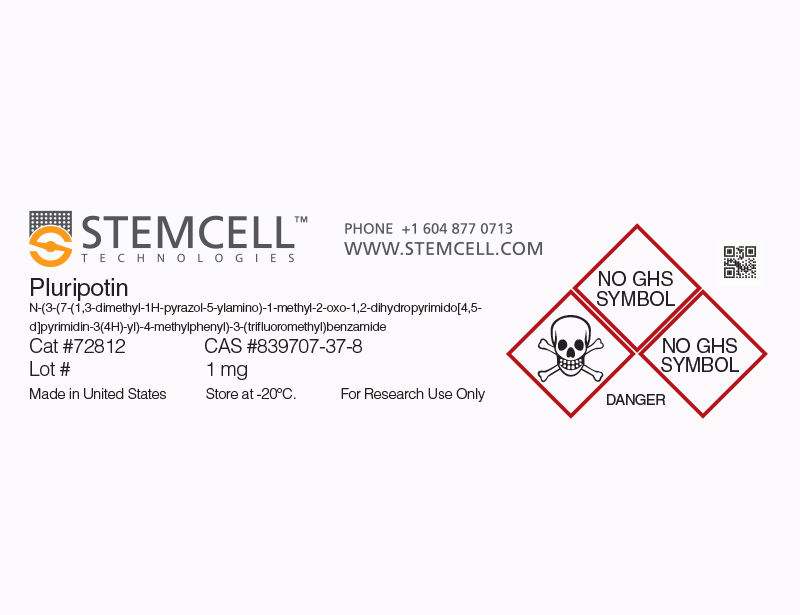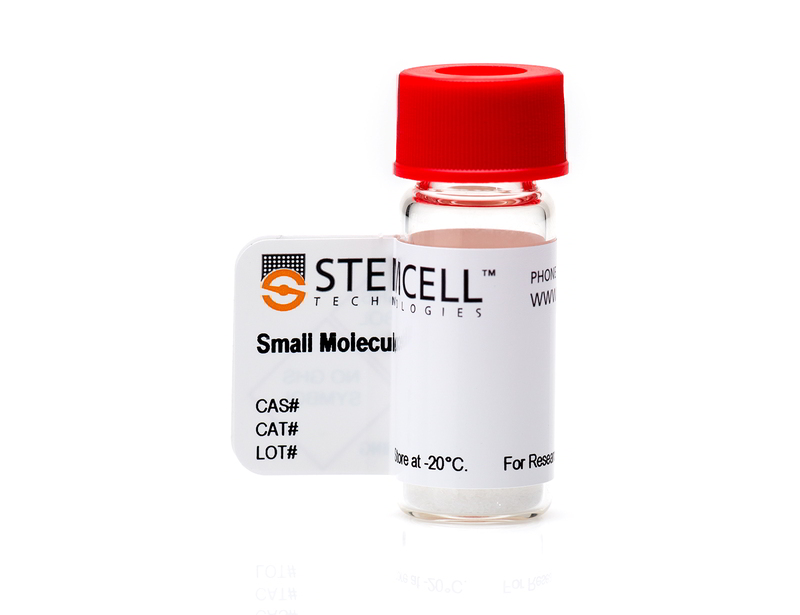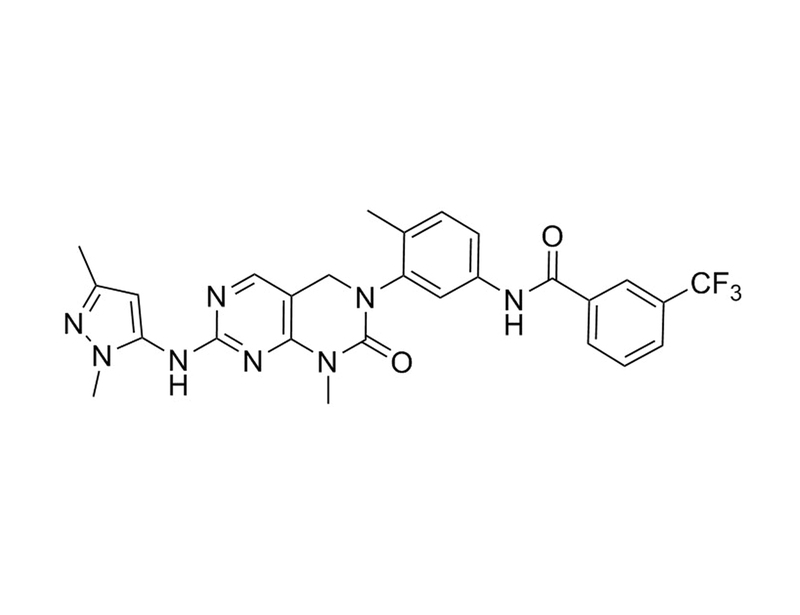Pluripotin
PI3K and MEK/ERK pathway inhibitor; Inhibits RasGAP and ERK1
概要
Pluripotin inhibits both Ras GTPase-activating protein (RasGAP, Kd = 98 nM) and extracellular signal-regulated kinase 1 (ERK1, Kd = 212 nM; Chen et al.). Inhibition of RasGAP increases Ras signaling via the PI3-kinase pathway which promotes self-renewal, whereas inhibition of ERK1 blocks differentiation (Chen et al.).
MAINTENANCE AND SELF-RENEWAL
· Promotes self-renewal and maintains mouse embryonic stem (ES) cells in an undifferentiated, pluripotent state in the absence of feeder cells, serum and leukemia inhibitory factor (LIF) for at least 10 passages (Chen et al.; Xiong et al.).
· When combined with LIF, improves efficiency of ES cell derivation from refractory mouse strains (Pieters et al.; Yang et al.).
MAINTENANCE AND SELF-RENEWAL
· Promotes self-renewal and maintains mouse embryonic stem (ES) cells in an undifferentiated, pluripotent state in the absence of feeder cells, serum and leukemia inhibitory factor (LIF) for at least 10 passages (Chen et al.; Xiong et al.).
· When combined with LIF, improves efficiency of ES cell derivation from refractory mouse strains (Pieters et al.; Yang et al.).
Alternative Names
SC-1
Cell Type
Pluripotent Stem Cells
Species
Human, Mouse, Rat, Non-Human Primate, Other
Application
Expansion, Maintenance
Area of Interest
Stem Cell Biology
CAS Number
839707-37-8
Chemical Formula
C₂₇H₂₅F₃N₈O₂
Molecular Weight
550.5 g/mol
Purity
≥ 98%
Pathway
PI3K/AKT, MEK/ERK
Target
ERK, RasGAP
技术资料
| Document Type | 产品名称 | Catalog # | Lot # | 语言 |
|---|---|---|---|---|
| Product Information Sheet | Pluripotin | 72812, 72814 | All | English |
| Safety Data Sheet | Pluripotin | 72812, 72814 | All | English |
数据及文献
Publications (4)
Stem cell reviews 2012 SEP
Efficient and user-friendly pluripotin-based derivation of mouse embryonic stem cells.
Abstract
Abstract
Classic derivation of mouse embryonic stem (ES) cells from blastocysts is inefficient, strain-dependent, and requires expert skills. Over recent years, several major improvements have greatly increased the success rate for deriving mouse ES cell lines. The first improvement was the establishment of a user-friendly and reproducible medium-alternating protocol that allows isolation of ES cells from C57BL/6 transgenic mice with efficiencies of up to 75%. A recent report describes the use of this protocol in combination with leukemia inhibitory factor and pluripotin treatment, which made it possible to obtain ES cells from F1 strains with high efficiency. We report modifications of these protocols for user-friendly and reproducible derivation of mouse ES cells with efficiencies of up to 100%. Our protocol involves a long initial incubation of primary outgrowths from blastocysts with pluripotin, which results in the formation of large spherical outgrowths. These outgrowths are morphologically distinct from classical inner cell mass (ICM) outgrowths and can be easily picked and trypsinized. Pluripotin was omitted after the first trypsinization because we found that it blocks attachment of ES cells to the feeder layer and its removal facilitated formation of ES cell colonies. The newly established ES cells exhibited normal karyotypes and generated chimeras. In summary, our user-friendly modified protocol allows formation of large spherical ICM outgrowths in a robust and reliable manner. These outgrowths gave rise to ES cell lines with success rates of up to 100%.
Journal of visualized experiments : JoVE 2009 JAN
The use of SC1 (Pluripotin) to support mESC self-renewal in the absence of LIF.
Abstract
Abstract
Mouse embryonic stem (ES) cells are conventionally cultured with Leukemia Inhibitory Factor (LIF) to maintain self-renewal.(1) However, LIF is expensive and activation of the LIF/JAK/STAT3 pathway is not absolutely required to maintain the self-renewal state.(2) The SC1 small molecule may be an economical alternative to LIF. SC1 functions through dual inhibition of Ras-GAP and ERK1.(3) Illustration of its mechanism of action makes it a useful tool to study the fundamental molecular mechanism of self-renewal. Here we demonstrate the procedure for culturing mouse ES cells in the presence of SC1 and show that they are able to maintain self-renewal in the absence of LIF. Cells cultured with SC1 showed similar morphology compared to cells maintained with LIF. Both exhibited typical mouse ES morphology after five passages. Expression of typical pluripotency markers (Oct4, Sox2, Nanog, and SSEA1) was observed after five passages in the presence of SC1. Furthermore, SC1 caused no overt toxicity on mouse ES cells.
Stem cells (Dayton, Ohio) 2009 FEB
Pluripotin combined with leukemia inhibitory factor greatly promotes the derivation of embryonic stem cell lines from refractory strains.
Abstract
Abstract
Most mouse embryonic stem (ES) cells are derived from a 129 or C57BL/6 background, whereas the derivation efficiency of ES cells is extremely low on certain refractory types of background for which ES cells are highly desired. Here we report an optimized, highly efficient protocol by combining pluripotin, a small molecule, and leukemia inhibitory factor (LIF) for the derivation of mouse ES cells. With this method, we successfully isolated ES cell lines from five strains of mice, with an efficiency of 57% for NOD-scid, 63% for SCID beige, 80% for CD-1, and 100% for two F1 strains from C57BL/6xCD-1. By tracking the Oct4-positive cells in the Oct4-green fluorescent protein embryos in the process of ES cell isolation, we found that pluripotin combined with LIF improved the efficiency of ES cell isolation by selectively maintaining the Oct4-positive cells in the outgrowth. To our knowledge, this is the first report of ES cells being efficiently derived from immunodeficient mice on refractory backgrounds (NOD-scid on a NOD background and SCID beige on a BALB/c background).
Proceedings of the National Academy of Sciences of the United States of America 2006 NOV
Self-renewal of embryonic stem cells by a small molecule.
Abstract
Abstract
A cell-based screen of chemical libraries was carried out to identify small molecules that control the self-renewal of ES cells. A previously uncharacterized heterocycle, SC1, was discovered that allows one to propagate murine ES cells in an undifferentiated, pluripotent state under chemically defined conditions in the absence of feeder cells, serum, and leukemia inhibitory factor. Long-term SC1-expanded murine ES cells can be differentiated into cells of the three primary germ layers in vitro and also can generate chimeric mice and contribute to the germ line in vivo. Biochemical and cellular experiments suggest that SC1 works through dual inhibition of RasGAP and ERK1. Molecules of this kind may not only facilitate practical applications of stem cells in research and therapy, but also provide previously undescribed insights into the complex biology of stem cells.




